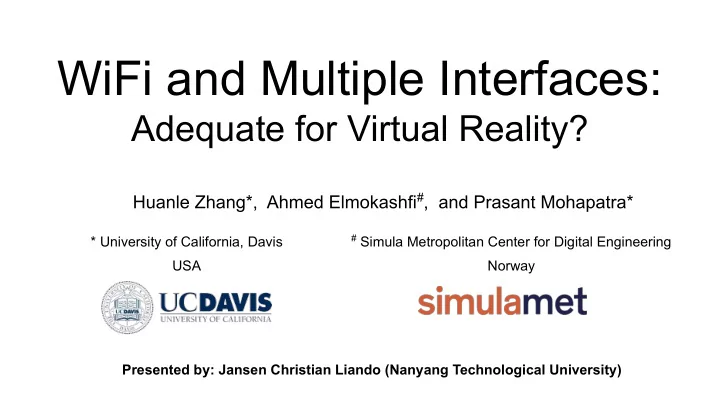

WiFi and Multiple Interfaces: Adequate for Virtual Reality? Huanle Zhang*, Ahmed Elmokashfi # , and Prasant Mohapatra* # Simula Metropolitan Center for Digital Engineering * University of California, Davis USA Norway Presented by: Jansen Christian Liando (Nanyang Technological University)
360-degree Panoramic Videos Stage Data Rate RTT Early 25 Mbit/s 40 ms Entry 100 Mbit/s 30 ms Advanced 418 Mbit/s 20 ms Ultimate 2.35 Gbit/s 10 ms Table: Network requirements for VR 360 Image source: www.vectorstock.com Data source: Huawei Technologies, Whitepaper on the VR-Oriented Bearer Network Requirement, 2016
WiFi Support for VR Headsets ● High-quality VR headsets: Cable transmission (HDMI or USB3) ○ Drawback: ■ Not user-friendly (limited mobility) ■ Potential safety hazard ● Ubiquitousness of WiFi systems VR 360 WiFi Win-Win Situation Image source: www.vectorstock.com
Preliminary Study of IEEE 802.11ac 1. Working on 5G frequency bands 2. Supported maximum data rate: 6.9 Gpbs ○ 160 MHz Frequency band ○ 256-QAM Ultimate 2.35 Gbit/s 10 ms ○ 8 Spatial Streams (NSS=8) VR 360 ○ 400 ns Guard Interval (GI) Data Rate Latency Image source: www.vectorstock.com Data source: 802.11ac-2013 part 11: Wireless lan medium access control (MAC) and physical layer (PHY) specifications. Standard, IEEE, 2013
Measurement Setup Measurement setup Device
Measuring Network Latency Figure 1. One day trace of RTT Observation (862650 packets): 1. 50% packets RTT < 1.8 ms 2. 0.04% packets RTT > 10 ms High delay and High jitter 3. Maximum RTT = 227 ms 4. 24.2% packets jitter > 1ms 5. Maximum jitter = 226 ms
Locating Root Cause: Dissecting Network Stack Record timestamp of packets entering and leaving each network layer Debugfs virtual file system to log data Figure 2. Network stack from the perspective of Linux code structure
Latency from Upper Layers Figure 3. UDP to IP delay Figure 4. IP to UDP delay Figure 5. UDP to mac80211 delay Min: 24 us, Median: 41 us, Max: 145 us Negligible Image source: www.vectorstock.com
Latency from Channel Transmission Channel transmission time : a packet enters the ath10k driver layer until the driver receives ACK from the peer driver Figure 6. Channel transmission time Observations of channel transmission time: 1. Dominates RTT (min: 0.3ms, median: 0.9ms, max: 127ms) 2. Increases with the background traffic (e.g., 13PM-17PM) 3. Good indicator for RTT (envelope correlation coefficient: 0.71)
Proposal: Multiple WiFi Network Interface Cards Each NIC runs on non-overlapping channels Duplicate packets to both NICs PC Engines apu2 board QCA9888 802.11ac NIC OpenWrt OS MPTCP v0.93 Figure 7. Setup
UDP Improvement Figure 8. RTT for multiple interfaces. Top to bottom: interface 1, interface 2 and the combined interface 28.6% RTT Reduction
TCP Improvement Figure 9. Median, 5 and 95 percentiles of RTTs for the best interface and the combined interface 38.9% RTT Reduction
Channel Correlations Channels selection is NOT simple! Figure 10. Channel correlations
Future Works 1. More WiFi NICs 2. Multiple Interface Scheduling
Conclusion Purely Wi-Fi based transmission systems to support VR applications We believe that using multiple NICs is the right direction for building extremely high throughput, low latency and robust WiFi networks. Code release: https://github.com/dtczhl/dtc-openwrt
Q & A Thank you!!!
Recommend
More recommend